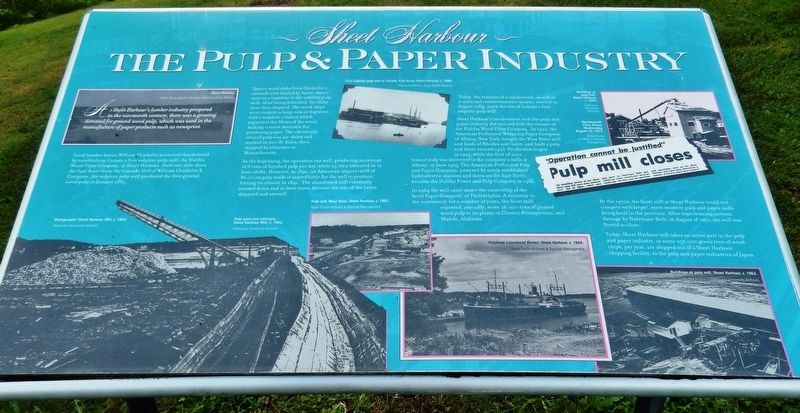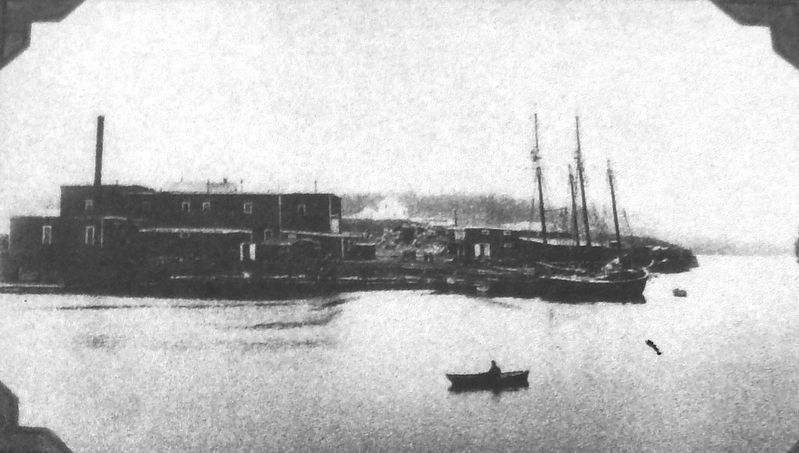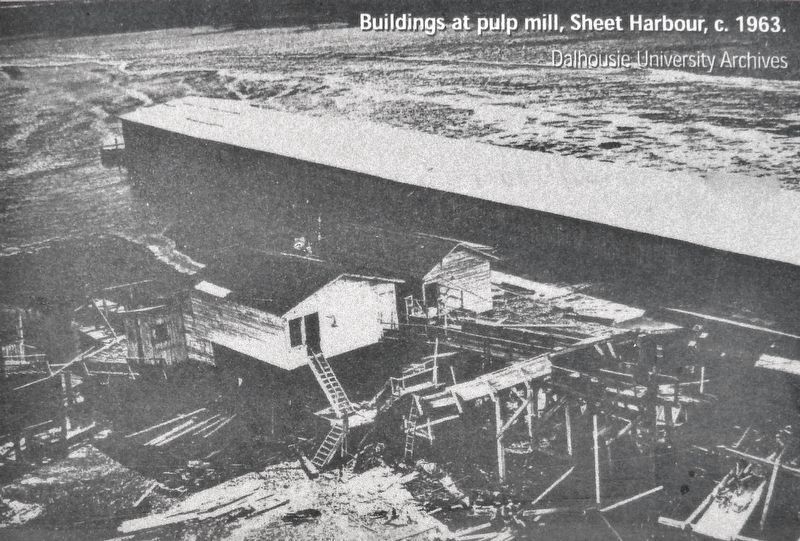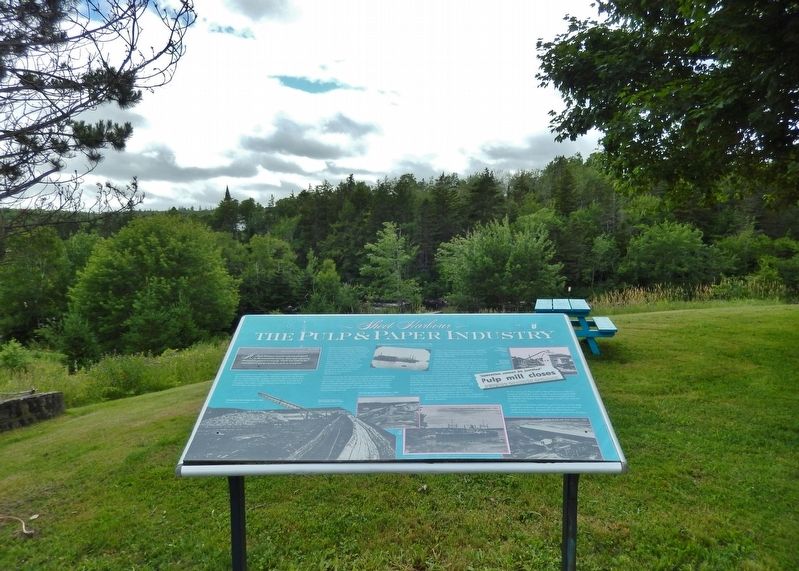Sheet Harbour in Halifax Region, Nova Scotia — The Atlantic Provinces (North America)
The Pulp & Paper Industry
— Sheet Harbour —
Local lumber baron William Chisholm answered this demand by establishing Canada's first sulphite pulp mill, the Halifax Wood Fibre Company, at Sheet Harbour. Built one mile down the East River from the Cascade Mill of William Chisholm & Company, the sulphite pulp mill produced the first ground wood pulp in January 1885.
Spruce wood slabs from Chisholm's sawmill were hauled by horse-drawn cars on a tramline to the sulphite pulp mill. After being debarked, the slabs were then chipped. The wood chips were cooked in large vats or digesters with a sulphite solution which separated the fibres of the wood, making it more desirable for producing paper. The chemically treated pulp was air-dried and stacked in 200 lb. bales, then shipped by schooner to Massachusetts.
In the beginning, the operation ran well, producing an average of 8 tons of finished pulp per day, while 25 men laboured in 12-hour shifts. However, in 1890, an American import tariff of $6.00 on pulp made it unprofitable for the mill to produce, forcing its closure in 1891. The abandoned mill eventually burned down and in later years, became the site of the Lewis shipyard and sawmill.
Today, the remains of a smokestack, as well as a cairn and commemorative plaque, erected in August 1984, mark the site of Canada's first sulphite pulp mill.
Sheet Harbour's involvement with the pulp and paper industry did not end with the closure of the Halifax Wood Fibre Company. In 1922, the American Perforated Wrapping Paper Company, of Albany, New York, bought the West River mill and lands of Rhodes and Curry, and built a pulp mill there around 1923. Production began in 1925, while the first of 1100 tons of pulp was delivered to the company's mills at Albany, in June 1925. The American Perforated Pulp and Paper Company, powered by newly established hydroelectric stations and dams on the East River, became the Halifax Power and Pulp Company in 1933.
In 1964 the mill came under the ownership of the Scott Paper Company, of Philadelphia. A mainstay in the community for a number of years, the Scott mill exported, annually, some 26 000 tons of ground wood pulp to its plants in Chester Pennsylvania, and Mobile, Alabama.
By the 1970s, the Scott mill at Sheet Harbour could not compete with larger, more modern pulp and paper mills being built in the province. After experiencing serious damage by Hurricane Beth, in August of 1971, the mill was forced to close.
Today, Sheet Harbour still takes an active part
in the pulp and paper industry, as some 250 000 green tons of wood chips, per year, are shipped out of a Sheet Harbour chipping facility, to the pulp and paper industries of Japan.
(photo captions)
• Sheet Harbour Mill, c. 1963. (background image) [Dalhousie University Archives]
• Pulp Mill, West River, Sheet Harbour, c. 1963. [Nova Scotia Archives & Records Management]
• Dartmouth Free Press, Wednesday, August 25, 1971. [Nova Scotia Archives & Records Management]
Topics. This historical marker is listed in this topic list: Industry & Commerce. A significant historical month for this entry is January 1885.
Location. 44° 55.629′ N, 62° 32.63′ W. Marker is in Sheet Harbour, Nova Scotia, in Halifax Region. Marker can be reached from Marine Drive (Nova Scotia Trunk Highway 7), 0.3 kilometers east of Highway 224, on the right when traveling east. Marker is located on the grounds of the MacPhee House Museum & Visitor Centre, near the west side of the parking lot. Touch for map. Marker is at or near this postal address: 22404 Nova Scotia Trunk Highway 7, Sheet Harbour NS B0J 3B0, Canada. Touch for directions.
Other nearby markers. At least 8 other markers are within 19 kilometers of this marker, measured as the crow flies. Sheet Harbour (here, next to this marker); Lumbering & Sawmills (a few steps from this marker); The Community (a few steps from this marker); Salmon
(within shouting distance of this marker); Shipbuilding & Shipping (approx. 1.5 kilometers away); Hydroelectric Power (approx. 1.5 kilometers away); Early Settlement (approx. 1.5 kilometers away); Prince Alfred Arch / L'Arche Prince Alfred (approx. 18.3 kilometers away). Touch for a list and map of all markers in Sheet Harbour.
Related markers. Click here for a list of markers that are related to this marker. Sheet Harbour, Nova Scotia
Also see . . . Pulp and Paper in Canada: Its First Century. The massive bounty of Canada’s natural resources compared with its sparse population historically dictated that it exported most of what it produced, and in this regard pulp and paper was no different. While the United States, by far Canada’s biggest trading partner for most of the twentieth century, had erected stiff tariffs in the late 1800s on all pulp and paper products, by the eve of World War I it had eliminated the duty on one item: newsprint. Thus, Canada’s plentiful timber resources and water powers were ideal for producing newsprint, a product towards which American trade policy was also favourably disposed. (Submitted on March 5, 2020, by Cosmos Mariner of Cape Canaveral, Florida.)
Credits. This page was last revised on March 5, 2020. It was originally submitted on March 3, 2020, by Cosmos Mariner of Cape Canaveral, Florida. This page has been viewed 502 times since then and 67 times this year. Photos: 1. submitted on March 3, 2020, by Cosmos Mariner of Cape Canaveral, Florida. 2, 3, 4, 5, 6. submitted on March 5, 2020, by Cosmos Mariner of Cape Canaveral, Florida.





